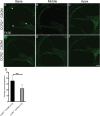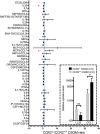Chemokine Receptor CCR2 Is Protective toward Outer Hair Cells in Chronic Suppurative Otitis Media
- PMID: 39264736
- PMCID: PMC11447675
- DOI: 10.4049/immunohorizons.2400064
Chemokine Receptor CCR2 Is Protective toward Outer Hair Cells in Chronic Suppurative Otitis Media
Abstract
Chronic suppurative otitis media (CSOM) is a neglected disease that afflicts 330 million people worldwide and is the most common cause of permanent hearing loss among children in the developing world. Previously, we discovered that outer hair cell (OHC) loss occurred in the basal turn of the cochlea and that macrophages are the major immune cells associated with OHC loss in CSOM. Macrophage-associated cytokines are upregulated. Specifically, CCL-2, an important member of the MCP family, is elevated over time following middle ear infection. CCR2 is a common receptor of the MCP family and the unique receptor of CCL2. CCR2 knockout mice (CCR2-/-) have been used extensively in studies of monocyte activation in neurodegenerative diseases. In the present study, we investigated the effect of CCR2 deletion on the cochlear immune response and OHC survival in CSOM. The OHC survival rate was 84 ± 12.5% in the basal turn of CCR2+/+ CSOM cochleae, compared with was 63 ± 19.9% in the basal turn of CCR2-/- CSOM cochleae (p ≤ 0.05). Macrophage numbers were significantly reduced in CCR2-/- CSOM cochleae compared with CCR2+/+ CSOM cochleae (p ≤ 0.001). In addition, CCL7 was upregulated, whereas IL-33 was downregulated, in CCR2-/- CSOM cochleae. Finally, the permeability of the blood-labyrinth barrier in the stria vascularis remained unchanged in CCR2-/- CSOM compared with CCR2+/+ CSOM. Taken together, the data suggest that CCR2 plays a protective role through cochlear macrophages in the CSOM cochlea.
Copyright © 2024 The Authors.
Conflict of interest statement
The authors have no financial conflicts of interest.
Figures




Similar articles
-
Influence of CX3CR1 Deletion on Cochlear Hair Cell Survival and Macrophage Expression in Chronic Suppurative Otitis Media.Otol Neurotol. 2023 Jul 1;44(6):605-610. doi: 10.1097/MAO.0000000000003884. Otol Neurotol. 2023. PMID: 37315234 Free PMC article.
-
Targeting the NLRP3 inflammasome in cochlear macrophages protects against hearing loss in chronic suppurative otitis media.J Neuroinflammation. 2024 Sep 14;21(1):223. doi: 10.1186/s12974-024-03212-6. J Neuroinflammation. 2024. PMID: 39277762 Free PMC article.
-
Chronic suppurative otitis media causes macrophage-associated sensorineural hearing loss.J Neuroinflammation. 2022 Sep 12;19(1):224. doi: 10.1186/s12974-022-02585-w. J Neuroinflammation. 2022. PMID: 36096817 Free PMC article.
-
Current concepts in the pathogenesis and treatment of chronic suppurative otitis media.J Med Microbiol. 2015 Oct;64(10):1103-1116. doi: 10.1099/jmm.0.000155. Epub 2015 Aug 5. J Med Microbiol. 2015. PMID: 26248613 Free PMC article. Review.
-
Mapping of audiometric analysis with microbiological findings in patients with chronic suppurative otitis media (CSOM): a neglected clinical manifestation.Crit Rev Clin Lab Sci. 2023 May;60(3):212-232. doi: 10.1080/10408363.2022.2158173. Epub 2023 Jan 5. Crit Rev Clin Lab Sci. 2023. PMID: 36604829 Review.
References
-
- Venkatesan, N., Perumal G., Doble M.. 2015. Bacterial resistance in biofilm-associated bacteria. Future Microbiol. 10: 1743–1750. - PubMed
Publication types
MeSH terms
Substances
Grants and funding
LinkOut - more resources
Full Text Sources
Miscellaneous

